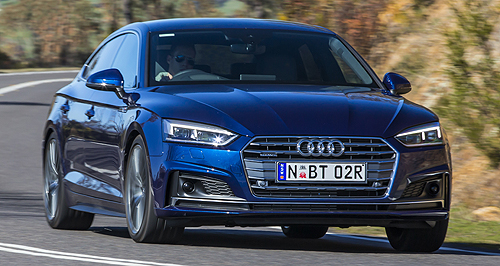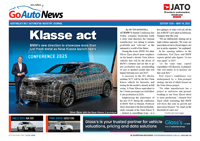News - General News - RegulationFuel-efficient vehicles miss annual LCT cutFuel for thought: While the Audi RS3 sedan (left) has had an LCT-induced price cut, the price of the A5 2.0 TFSI Quattro has not changed as it consumes less than 7.0L/100km. Threshold changes to LCT make thirstier premium cars cheaper29 Aug 2017 PREMIUM car manufacturers have passed on savings of around $300 to consumers thanks to reductions in the luxury car tax (LCT) for the new financial year, however fuel-efficient vehicles have missed out on a cut. As of July 1, the LCT threshold has been raised by $962 compared with the outgoing financial year, with premium motor vehicles now subjected to a 33 per cent tax on every dollar beyond $65,094 compared with $64,132 last year. The saving should be $317.50, as it is 33 per cent of the reduced amount of $962. Fuel-efficient vehicles – defined by the federal government as not exceeding 7.0 litres per 100 kilometres according to official combined-cycle laboratory testing – have not received the same tax cut, however, with the LCT-free threshold of $75,526 remaining static for the second financial year in a row for such models. Some of the car industry’s largest critics of the LCT have recently announced the reduction of the recommended retail price for a significant number of models, including Audi, BMW, Jaguar, Lexus, Mercedes-Benz, Porsche and Volvo. Audi has passed on cuts to its range starting with the RS3 sedan, which falls by $289 to $84,611 plus on-road costs, and the S4 sedan which drops by the same amount to $99,611. Where both consume more than 7.0L/100km, the more fuel efficient and similarly priced A5 2.0 TFSI Quattro remains pegged at $81,500 because it consumes 6.5L/100km – under the threshold and 1.9L/100km below RS3. BMW has moved its 440i Convertible (rated at 7.2L/100km) down by $290 to $117,610 – however the 440i coupe (6.8L/100km) is unchanged at $99,900. Jaguar has dropped affected vehicles by $289, with the XE 25t Portfolio ($69,872) and XE S ($104,777) among the most affordable examples of new prices, while the Lexus IS350 F-Sport and Mercedes-AMG CLA45 drop by the same amount to $73,251 and $92,611 respectively. Porsche, meanwhile, has moved its entire line-up of affected vehicles down by $300 starting with the Boxster (now $115,300) but excluding the Panamera 4S Diesel (rated at 6.8L/100km) which remains at $318,600. The Volvo S60 Polestar also moves down by $288 to $89,702. According to LCT legislation the thresholds are indexed each year based on movement of the All Group Consumer Price Index (CPI). The equation for the calculations for each new financial year is “the sum of the index numbers for 2016-17, divided by the sum of the index numbers for 2015-16”. This year the indexation works out to be 1.015 which means last year’s LCT of $64,132 is multiplied by that figure to become the new threshold – $65,094. Fuel-efficient vehicles are calculated the same way, however not to the broader CPI but rather only the motor vehicle sub-segment of the annual CPI findings. Based on those calculations the indexation works out to be 0.984 – but a figure of less than one in any case amounts to no change in the LCT threshold, according to legislation. The only premium car brand that does not benefit from the lowering of the LCT threshold for non-fuel-efficient vehicles is Tesla, due to its all-electric line-up. In response to the LCT changes for the new financial year, Tesla Australia and New Zealand senior marketing and communications manager Heath Walker told GoAuto: “A change of the threshold in accordance with CPI will not have an impact on accelerating the adoption of electric vehicles. “We will continue to encourage the government to look at the future opportunity through removal of LCT on electric vehicles.” Asked if Audi was frustrated that an RS3 received a government-funded price cut but a more fuel-efficient, similarly priced A5 2.0 TFSI coupe did not, Audi Australia marketing and communications director Anna Burgdorf replied in a statement: “We strongly believe that the government should be fully supportive of the industry’s drive to reduce consumption and so in 2017, any incentive scheme, be it a tax or otherwise, should reward more fuel-efficient vehicles. “It offers consumers with more encouragement and incentive to adopt more fuel-efficient engines, and increasingly, hybrid and electric vehicles. “The luxury car tax has always been a rudimentary penalty for consumers who wish to spend more than the arbitrary threshold amounts on vehicles that often showcase the highest levels of safety and efficiency technology.” Mercedes-Benz Australia/Pacific senior manager of public relations, product and corporate communications David McCarthy also blasted the indexed changes to the LCT that, compared with last year, has made less fuel-efficient cars cheaper than their low-emissions counterparts in percentage terms. “Quite why the government decided it needed a different method of calculation to the standard luxury car tax, we don’t know,” he said in an interview with GoAuto. “They (the federal government) have no desire to change it. As the other one increases, this one (sub-7.0L/100km concession) stays the same, and you’re actually penalising people who are buying a fuel-efficient vehicle. “You can only draw the conclusion that at the end of the day their commitment to encouraging low emissions doesn’t actually stretch to giving that the same basis as another luxury car – so, why? “Surely you would say, shouldn’t we be encouraging people to buy lower emission vehicles and higher technology vehicles? Yes. Oh, but ‘we won’t actually have a calculation method that reflects that, because that will cost us money’.” Mr McCarthy said that Mercedes-Benz Australia/Pacific would support a move to lower the reduced LCT concession for fuel efficient cars from 7.0L/100km to 5.0L/100km to encourage the adoption of low emissions vehicles, however the federal government had not entertained that idea.  |
Click to shareGeneral News articlesResearch General News Motor industry news |














Facebook Twitter Instagram